Key takeaways:
- Emotional engagement through personal narratives is essential in policy-making and advocacy, as it humanizes issues and fosters connections.
- Collaboration among stakeholders and grassroots movements significantly strengthens policy advocacy efforts.
- Using clear messaging and leveraging technology can enhance outreach and effectiveness in pro-life initiatives.
- Persistence and resilience are crucial in overcoming challenges within the advocacy landscape, leading to potential legislative successes.
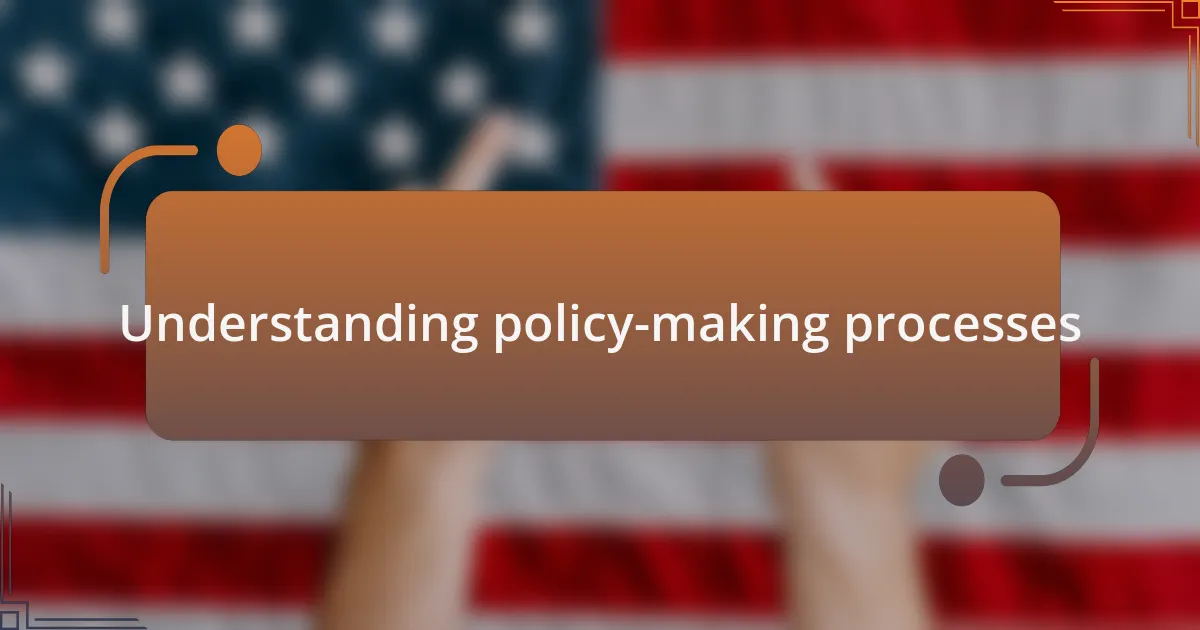
Understanding policy-making processes
Policy-making is a complex and multi-faceted process, often shaped by a blend of social values, economic considerations, and political pressures. I remember grappling with the layers involved when my organization sought to push for a more robust pro-life policy. It’s not just about presenting a strong argument; it’s about understanding the motivations and concerns of various stakeholders.
As I navigated through debates and discussions, I found that connecting emotionally with the issues at stake can be a game-changer. I often asked myself, “What makes someone truly care about this issue?” Engaging with personal stories, like those of women who regretted their choices, became vital. These narratives humanize policy discussions, reminding us that behind every statistic is a person with a story worth sharing.
Additionally, it became clear to me that timing and strategy are crucial in policy-making. During a crucial meeting, I witnessed how a well-timed call to action could shift the tide in our favor. The process can feel daunting, but when we actively participate and advocate for our beliefs, we can influence the decisions that shape our society. It’s a reminder that every small effort counts in the larger picture of policy advocacy.

Importance of pro-life advocacy
Pro-life advocacy is crucial for promoting the protection of life at all stages, which is a foundational value for many individuals and communities. Each time I joined a local advocacy event, I could feel the collective energy and passion of those who believe in safeguarding the unborn. It made me realize how necessary it is to have voices that passionately articulate these values, especially when they face opposition and misunderstanding.
When I reflect on the conversations I’ve had with undecided individuals, I often remember how impactful it is to share hope rather than fear. By presenting the positive outcomes of choosing life—stories of families who found joy and fulfillment through adoption, for instance—I’ve seen skeptics soften and reconsider their viewpoints. It’s a powerful reminder that pro-life advocacy isn’t solely about opposition; it’s about celebrating life and offering alternatives that resonate emotionally with people.
Moreover, the importance of pro-life advocacy extends beyond individual stories; it influences public policy and societal norms. During a recent campaign, I learned firsthand how grassroots efforts can lead to significant legislative changes. What if we could not just dream but consistently work towards a society that values life? I’ve realized that staying engaged, educating others, and sharing personal convictions can ripple outward, fostering a culture that truly respects the dignity of every life.
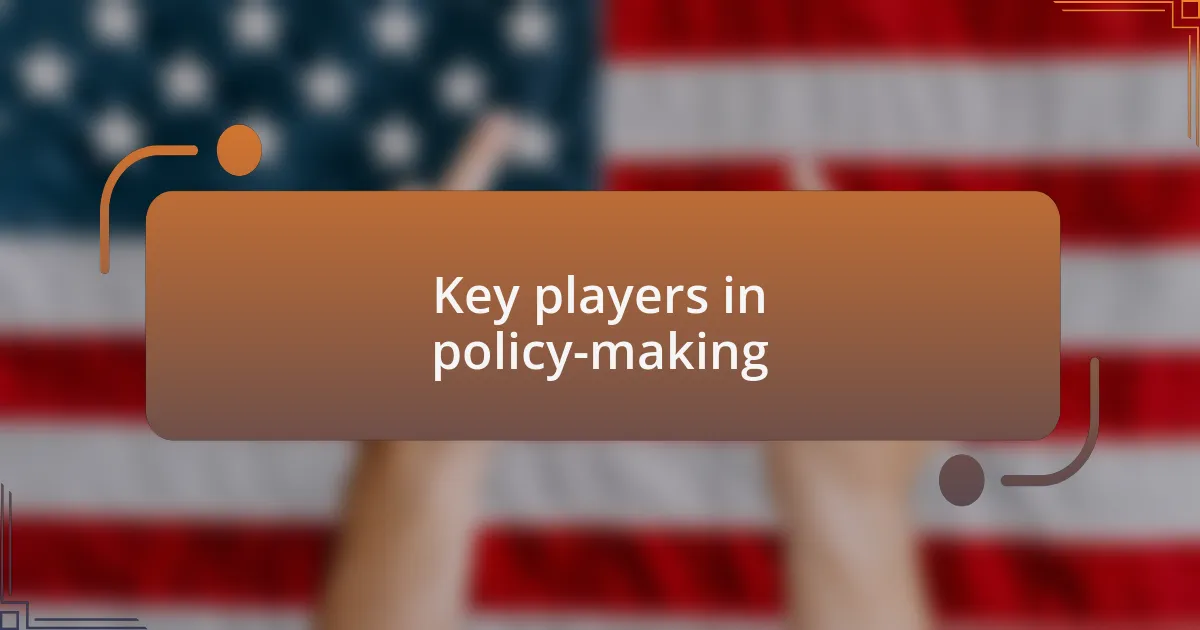
Key players in policy-making
When I consider the key players in policy-making, I immediately think of lawmakers. Their decisions directly shape the laws that govern our society, including issues related to life and family. I recall attending a town hall where a local representative openly discussed his stance on pro-life legislation, and it struck me how much personal beliefs and experiences can influence political agendas.
Equally important are the advocacy groups that tirelessly work behind the scenes, crafting messages and rallying support. I remember volunteering with one such group, where our team crafted a petition that garnered hundreds of signatures—seeing the public’s enthusiasm was incredibly motivating. These organizations not only serve as a bridge between the community and policymakers but also amplify voices that might otherwise go unheard.
Lastly, I can’t overlook the role of the community itself. Grassroots movements can be a powerful force in shaping policy. During a local rally, I was moved by the diverse background of participants united by a common goal: to protect life. It made me ponder the question—what can each of us do in our own neighborhoods to support and influence these discussions? It’s that collective effort that truly makes an impact on policy decisions.
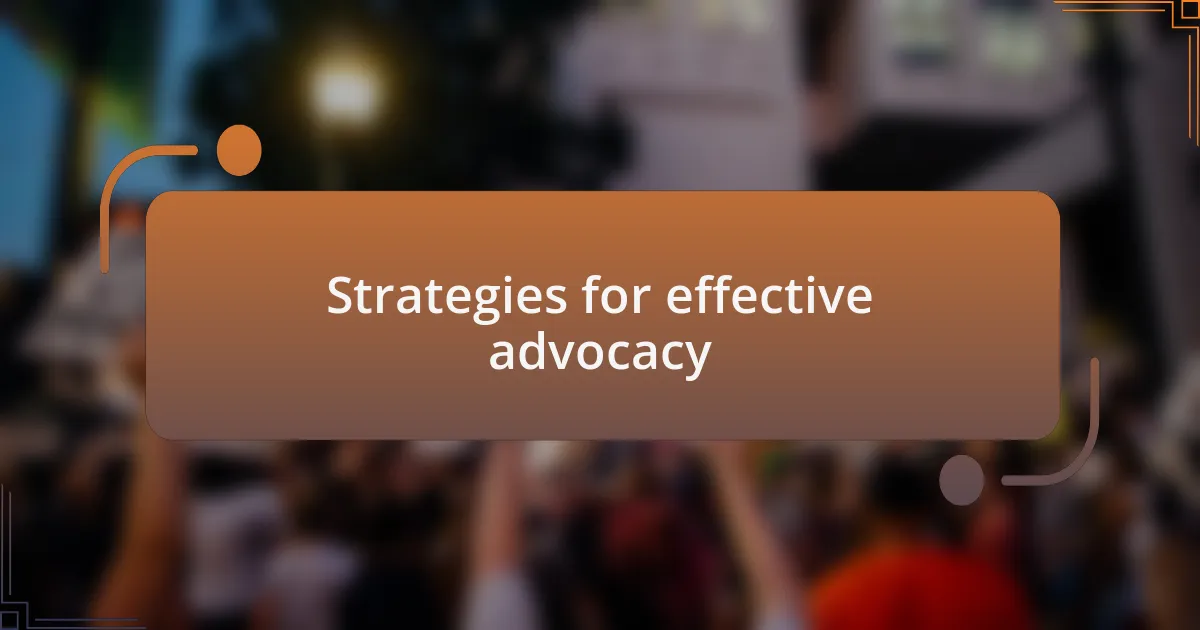
Strategies for effective advocacy
Effective advocacy requires a multifaceted approach, combining education with action. I recall a workshop I attended where seasoned advocates emphasized the importance of clarity in messaging. They taught us that when we articulate our values and beliefs in simple, relatable terms, we not only connect with our audience but also empower them to share our vision. Have you ever noticed how a well-phrased message can ignite passion in those around you?
Another strategy I’ve found invaluable is building coalitions. In my experience, working with other organizations amplifies our reach and resources. I remember collaborating with a coalition of various faith groups to organize a community forum. The diverse perspectives enriched our discussions and created a united front that was hard to ignore. How can collaborative efforts truly change the narrative surrounding sensitive topics like pro-life advocacy?
Lastly, personal stories have an uncanny ability to evoke empathy and understanding. During a speaking event, I shared my own journey in advocacy, focusing on a close friend who faced a challenging pregnancy. The reactions from the audience were profound; you could sense a shift in their perception. By sharing real experiences, we humanize the discussion and invite others to see the heart behind the policies. Isn’t it incredible how storytelling can bridge gaps and foster deeper connections in advocacy?
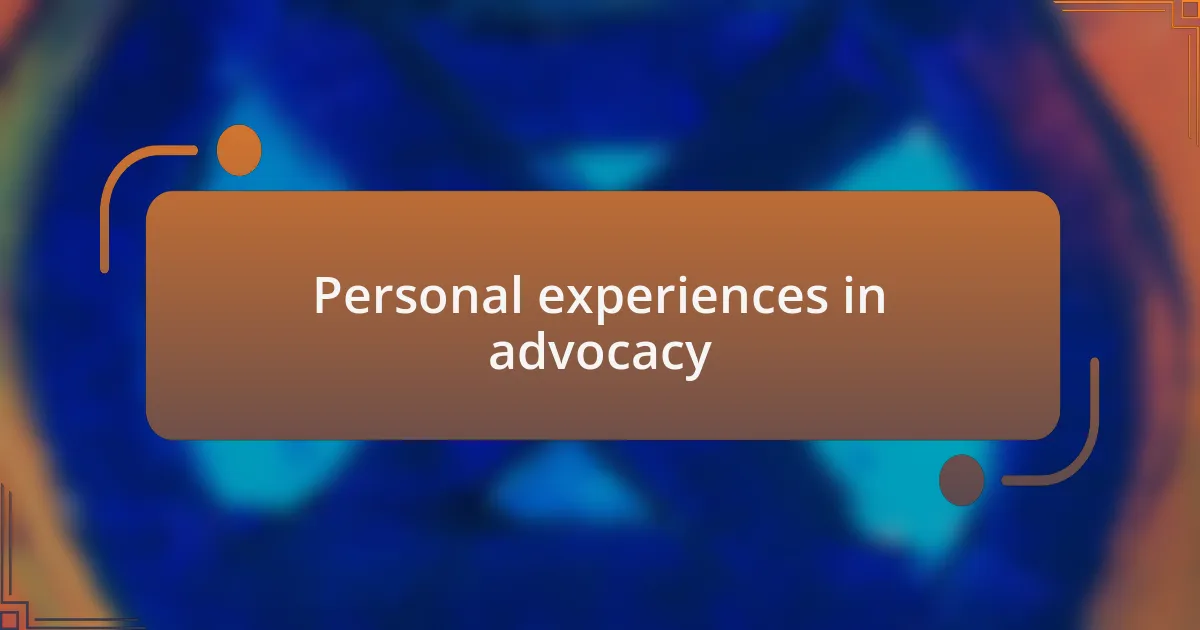
Personal experiences in advocacy
Advocacy isn’t just about conveying facts; it’s deeply personal. I remember being overwhelmed during a local rally when I spontaneously shared my own experience with a crisis pregnancy. The vulnerability I felt transformed into a powerful connection with those in attendance. Has there ever been a moment when sharing your story changed the way you saw a situation entirely?
One particular encounter stays etched in my mind. I met a young mother who had chosen life against all odds. Her candid account of choosing to embrace the difficulties of motherhood resonated with me. I realized that sharing our struggles makes the pro-life message more relatable and accessible. Could it be that our most profound lessons come from those who dare to be honest about their journeys?
Often, I reflect on how these personal experiences foster resilience in the advocacy landscape. I once led a workshop where participants were encouraged to share their stories. The energy in the room was electric, filled with raw emotion and shared determination. It struck me that these moments remind us of why we advocate—to create a brighter future for the generations to come. Have you felt that same sense of purpose when joining together with others in this vital mission?
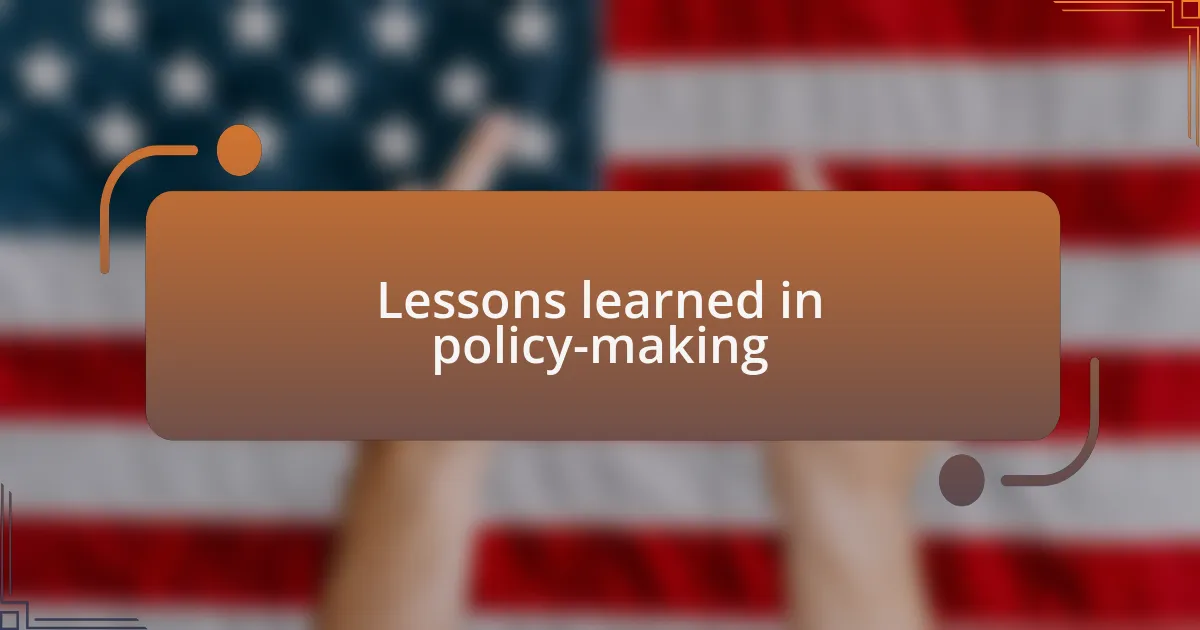
Lessons learned in policy-making
In my journey through policy-making, I’ve discovered that collaboration is not just beneficial but essential. During a meeting with various stakeholders, a shared struggle surfaced: navigating differing opinions on reproductive issues. Through open dialogue, we found common ground, which not only strengthened our alliance but also improved our policy proposals. Have you ever experienced that moment when collaboration transforms a challenge into an opportunity?
Another important lesson I learned is the need for persistence. I recall advocating for a bill that seemed to face insurmountable opposition. Each setback felt discouraging, yet I realized that my determination was contagious. When I rallied my team to refocus our efforts, the small victories we achieved reignited our passion. How often do we underestimate the power of resilience in the face of challenge?
Additionally, understanding the nuances of communication in policy-making has been a revelation for me. I once participated in a town hall where my words about the sanctity of life were met with both applause and dissent. It taught me that framing our message empathetically can bridge divides. Reflecting on this, I often ask myself: how can we tailor our message to ensure it resonates with those who may disagree, ultimately fostering a more inclusive dialogue?
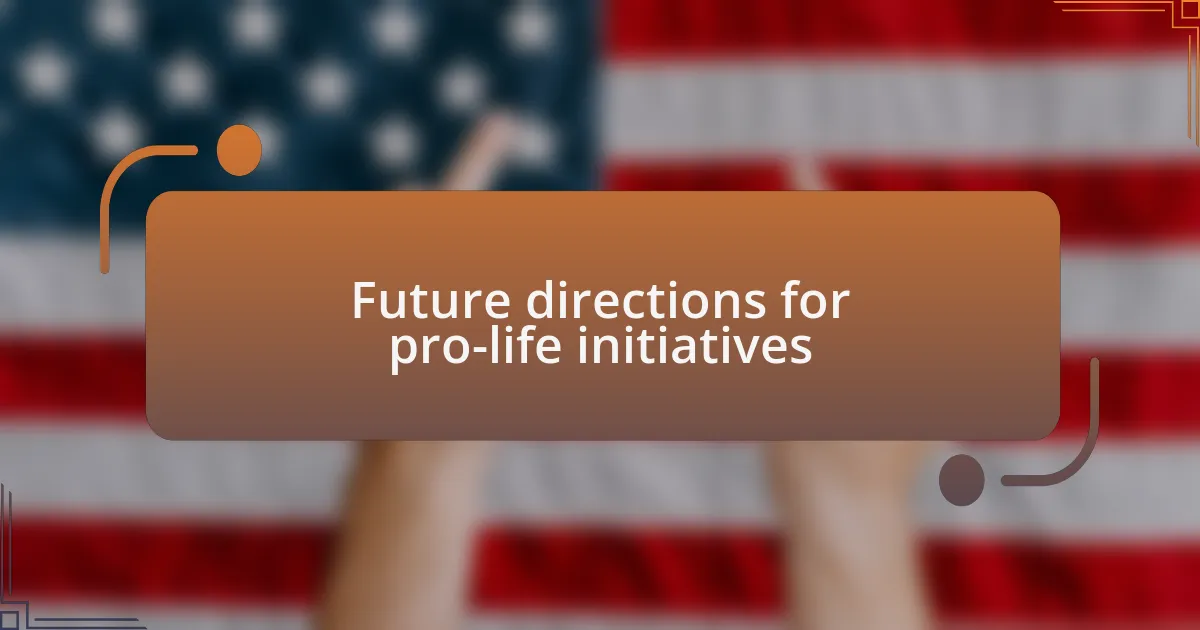
Future directions for pro-life initiatives
When I think about the future of pro-life initiatives, I see the potential for greater community engagement. I’ve participated in local events where individuals shared their personal stories about the impact of life-affirming choices. These narratives not only empower the movement but also foster a deeper connection with those who might initially oppose us. Have you ever witnessed how storytelling can shift perceptions and encourage empathy?
Technology, too, is shaping how we advocate for life. I remember attending a workshop on social media strategies tailored for pro-life movements. It opened my eyes to the effectiveness of using platforms to reach a broader audience, making our message more relatable and accessible. How can we better utilize the digital landscape to amplify our voices and highlight the invaluable stories of those choosing life?
Looking ahead, we must consider forging alliances with like-minded organizations. I discovered, during a collaborative project, the strength in unity among diverse groups working towards similar goals. Partnerships not only enhance resources but also broaden the reach of our initiatives. In what ways can we build these coalitions to create a more formidable front for pro-life advocacy?